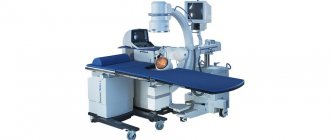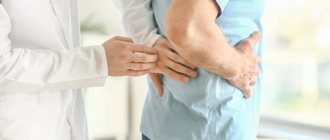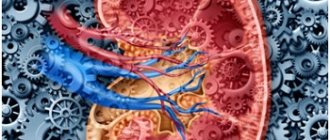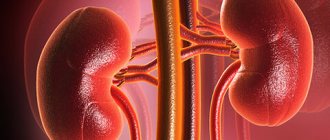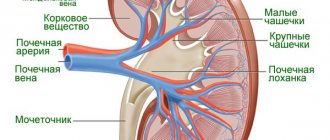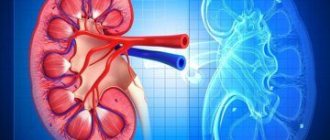Signs and symptoms
An attack of renal colic has a sudden onset. A person experiences acute pain in the lower back, quickly growing, sometimes radiating to the groin, genitals, thigh, or accompanied by an increased urge to urinate. The pain syndrome is often accompanied by nausea and vomiting. Changing body position does not reduce the intensity of pain - the patient “does not find a place for himself.” An attack of pain may be accompanied by the following symptoms:
- blood in urine;
- frequent urge to urinate;
- decreased urine volume or complete anuria;
- sharp pain in the bladder and urethra;
- bloating;
- feeling of bladder fullness;
- false urge to urinate;
- nausea;
- cold sweat;
- vomiting that does not bring relief;
- chills;
- pale skin;
- increased blood pressure;
- increased heart rate.
At the first sign of acute pain, you should call an ambulance to prevent the risk of serious complications.
Diet
To prevent colic, they resort to diet No. 7, except in the case of oxalate stones, when diet No. 6 is prescribed, which is used to treat gout.
Kidney diet No. 7 limits the consumption of table salt, includes mainly plant foods and an increased amount of daily fluid intake.
Oxalates
Oxalate stones look like dark-colored thorns. When moving through the ureter, the sharp edges injure the inner surface of the urinary tract, which leads to the appearance of blood in the urine.
Oxalate stones occur with normal urine acidity. The reason for the appearance of oxalate stones is a lack of fluid in the body.
Sorrel, spinach, legumes, and tomatoes are excluded from the menu; beets, carrots, black and green tea are limited. It is useful for oxalate stones to eat dishes with cucumbers, pears, apricots, grapes, Essentuki mineral water No. 20 are useful.
Phosphates
Round, grayish phosphate stones occur in alkaline urine and easily disintegrate when crushed by laser.
For phosphate stones, limit cottage cheese, milk, liver, and kidneys. Do not consume hot spices, smoked meats, cocoa, alcohol, or coffee. Mushrooms, chicken eggs in the diet, and sour cream are limited.
It is useful to drink birch sap and Arzni mineral water. Apples with a sour taste, cranberries, currants, lingonberries are recommended, carotenoids and vitamin D are necessary.
Urats
Hard, yellowish-colored urate stones form in an acidic environment with excess uric acid. For urate stones, it is useful to drink alkaline mineral waters of Essentuki No. 4, No. 17, Slavyanovskaya, Smirnovskaya.
It is recommended to limit meat products containing purines and increase the amount of plant foods, with the exception of legumes. For urate stones, it is useful to include dishes with parsley, celery, and drink a decoction of pumpkin seeds.
After renal colic caused by urolithiasis, the patient has been registered with a dispensary for 5 years. To prevent renal colic, patients must follow a diet, drinking regimen, avoid excessive physical activity, and avoid hypothermia. The video shows how to relieve renal colic and how to treat it:
gidmed.com
Causes of renal colic
The main cause of an acute attack is the sudden cessation or limitation of the outflow of urine from the pelvicaliceal system, due to compression or blockage of the urinary ducts. This condition can result from:
- obstruction of the urinary ducts with stones, blood clots, mucus clots, tumor fragments;
- tumor of the kidneys, ureter, prostate gland;
- some gynecological diseases (uterine fibroids, adnexitis);
- compression of the ureter by a tumor from the outside.
Renal vein thrombosis and renal infarction can also cause colic.
Western standards of treatment (evidence-based medicine)
Continuous staff development
Regular interaction with leading Russian and foreign medical institutions
Modern medical equipment and advanced diagnostic and treatment methods
Unified standard of service
We work around the clock 24/7/365
Make an appointment We will be happy to answer any questions Coordinator Oksana
Why is renal colic dangerous for you?
Renal colic is a ticking time bomb in your body. This term is used to describe acute paroxysmal pain in the lower back, the cause of which is impaired blood circulation in the kidney and difficulty in the outflow of urine. Severe pain occurs as a result of stretching of the renal pelvis due to urine pressure. The pain may be accompanied by fever, nausea, vomiting, dizziness and a sharp deterioration in overall health. Your performance decreases, physical and mental activity becomes difficult.
The main danger of renal colic is that it is a symptom of many dangerous kidney diseases that pose a serious threat not only to your health, but also to life. In some cases, renal colic is accompanied by renal failure.
Diagnostics
An emergency condition is differentiated from other pathologies accompanied by similar symptoms - acute appendicitis, torsion of a leg or rupture of an ovarian cyst, acute pancreatitis, etc. Differential diagnosis includes:
- examination by a urologist;
- Ultrasound of the kidneys and bladder;
- general urine analysis;
- CT scan of the abdominal cavity and retroperitoneal space.
A comprehensive examination includes taking an anamnesis, a thorough interview with the patient, and a set of blood and urine tests. At the GMS Hospital Urology Center, a differentiated examination is performed using high-precision, expert-class equipment and takes a minimum of time.
Why does it occur
To successfully provide effective assistance during an attack, it is necessary to understand what pathological process such pain is a symptom of.
Main reasons
The causes of an attack of renal colic can be very different, but most often it develops as a result of the following diseases:
- presence of stones;
- kidney prolapse;
- hydronephrotic transformation;
- renal colic can be caused by taking certain medications (metformin, corticosteroids, some antihistamines);
- thrombosis of renal vessels.
Mechanism of pain development
Stones in urolithiasis have different locations. Formed in the kidney, they migrate with the urine stream to all organs of the urinary system (ureters, bladder, urethra). Passing along these paths, they cause blockage, or irritate the mucous membrane with sharp edges, thereby causing a painful spasm, expressed in an attack of renal colic.
Oncopathology causes urinary retention and renal colic as a result of the appearance of blood clots or pieces of exfoliated tissue in the canals. With pyelonephritis, an attack occurs as a result of the inflammatory process and the appearance of mucus plugs. This also causes an attack.
When the kidney prolapses, colic is caused by torsion of the ureter, intensification occurs in a vertical position, and some decrease is noted in a horizontal position.
In women, some gynecological diseases (for example, inflammation of the appendages or uterine fibroids) lead to the development of adhesions, including in the kidneys. They are also accompanied by renal colic. To diagnose them, a consultation with a gynecologist is required.
Risk factors
Risk factors for developing an attack are:
- inherited predisposition (noted in 50% of cases);
- infectious diseases of the genitourinary area;
- prolonged fever;
- occupational hazards associated with chronic intoxication or overheating;
- anatomical features of the structure of the urinary organs;
- increased loss of fluid through sweat;
- reduced drinking regime;
- improper or insufficient nutrition;
- walking, traveling in public transport, running;
- excessive loads.
Treatment methods for renal colic
Therapeutic tactics have two main goals - rapid relief of acute pain and elimination of the cause that caused the attack and disruption of the urinary system. A wide range of conservative and surgical methods are used:
- drug therapy - painkillers and antispasmodics;
- ureteral stenting;
- puncture nephrostomy.
If the obstruction of the ureter is caused by a stone, contact laser crushing (lithotripsy) of the stone and removal of its fragments is performed. In case of colic, which occurs against the background of a tumor process, operations are performed to remove the formation, aimed at restoring the functioning of the urinary system.
Important! Since the cause of an acute pain attack can be many factors, there can be no talk of any self-medication! The first sign of renal colic is a reason to call an ambulance. The scope and methods of treatment can only be determined by a specialist who will conduct express diagnostics and, based on the results obtained, provide the necessary medical care efficiently and quickly.
The Urology Center at GMS Hospital successfully diagnoses and treats renal colic of any etiology. Treatment is carried out by leading specialists with many years of experience. During surgical interventions, endourological technologies and the possibilities of laser surgery are actively used.
You have questions? We will be happy to answer any questions Coordinator Tatyana
Treatment
The main causative factor of colic is urolithiasis and blockage of the urinary tract with stones. Treatment of an attack involves creating conditions for the passage of stones and facilitating the outflow of urine. After pain relief, you must perform the examinations recommended by your doctor. If nephrolithiasis is detected, medical or surgical treatment will be required. Possible treatment options:
- drug litholysis (dissolution of stones with drugs);
- crushing stones;
- surgery to remove the stone.
Removing stones will not solve the problem: against the background of kidney stones, you need to follow a diet and prevent the formation of stones in the urinary tract.
How to relieve pain during an attack
First aid for a primary attack includes the following procedures:
- heat on the lumbar region (heating pad, hot bath);
- injection of antispasmodic medication (No-shpa, Papaverine);
- use of pain medication.
Often this is enough to relieve a pain attack, but first aid measures do not solve the problem. If the examination is not started after the general condition improves, then the pain syndrome may recur in the near future.
Folk remedies are ineffective against the background of an attack of pain. It is pointless to try to remove the problem with herbal remedies and unconventional methods. Thermal procedures (bath, heating pad) can be used, but only in cases where there is complete confidence in the diagnosis.
Diet
For the entire period of treatment, the doctor will definitely advise you to give up alcohol and spicy food. In addition, dietary features for renal colic include:
- reducing the amount of table salt in food;
- a sharp decrease in carbohydrates in the diet (white bread, baked goods, cookies, cakes);
- refusal of fried, canned and pickled foods;
- a significant reduction in the amount of fatty and meat products;
- limiting vegetables and fruits that stimulate gas formation in the intestines (cabbage, apples, grapes).
If urolithiasis is detected, the doctor will prescribe a diet that will help prevent the formation of stones (for urate and oxalate stones, meat should be excluded, for phosphate stones, dairy and vegetable products should be excluded).
Prevention
Prevention of acute painful attacks consists of timely diagnosis and treatment of pathological conditions that can trigger the development of renal colic. Equally important is a healthy balanced diet, drinking regime, giving up bad habits, and sufficient physical activity. All patients who have had renal colic should be regularly monitored by a urologist. You can get as much information as possible at a consultation with a urologist/andrologist at the GMS Hospital Urology Center. You can make an appointment with a doctor around the clock - by phone or online.
How to cure renal colic as quickly as possible?
We offer an innovative method of color pulse therapy, the discovery of which was awarded the Nobel Prize.
The answer is obvious: in order for the genitourinary system to work well, the precise functioning of the brain centers responsible for its regulation must be debugged. The Neurodoctor device solves exactly this problem.
The device is based on the pulse therapy method. This is one of the most progressive and highly effective treatment methods known to modern world medicine. Thanks to pulse therapy, certain areas of the genitourinary system are “awakened”, which ensures the elimination of malfunctions in its functioning. This occurs due to the impact on the control centers of the brain.
How it works?
Neurodoctor affects the control centers of the brain.
The brain begins to produce dozens of neurohormones and form “corrective” nerve impulses.
Neurohormones are many times more effective than the most powerful drugs in quickly curing the disease. Nerve impulses eliminate pathological processes at the cellular level and correct the functioning of other organs and systems of the body.
LEARN MORE ABOUT THE METHOD
Differential diagnosis
With the development of colic in the kidneys, the symptoms are not typical only for a certain pathology. Similar signs can occur in a number of other acute painful conditions, and this leads to the need to carry out differential diagnosis with the following diseases:
- Acute processes in the abdominal cavity (appendicitis, cholecystitis, inflammation of the pancreas, perforation of an ulcer, intestinal obstruction).
- Acute process in women from gynecology.
- Aortic aneurysm.
- Radiculitis, neuralgia, intervertebral hernia.
